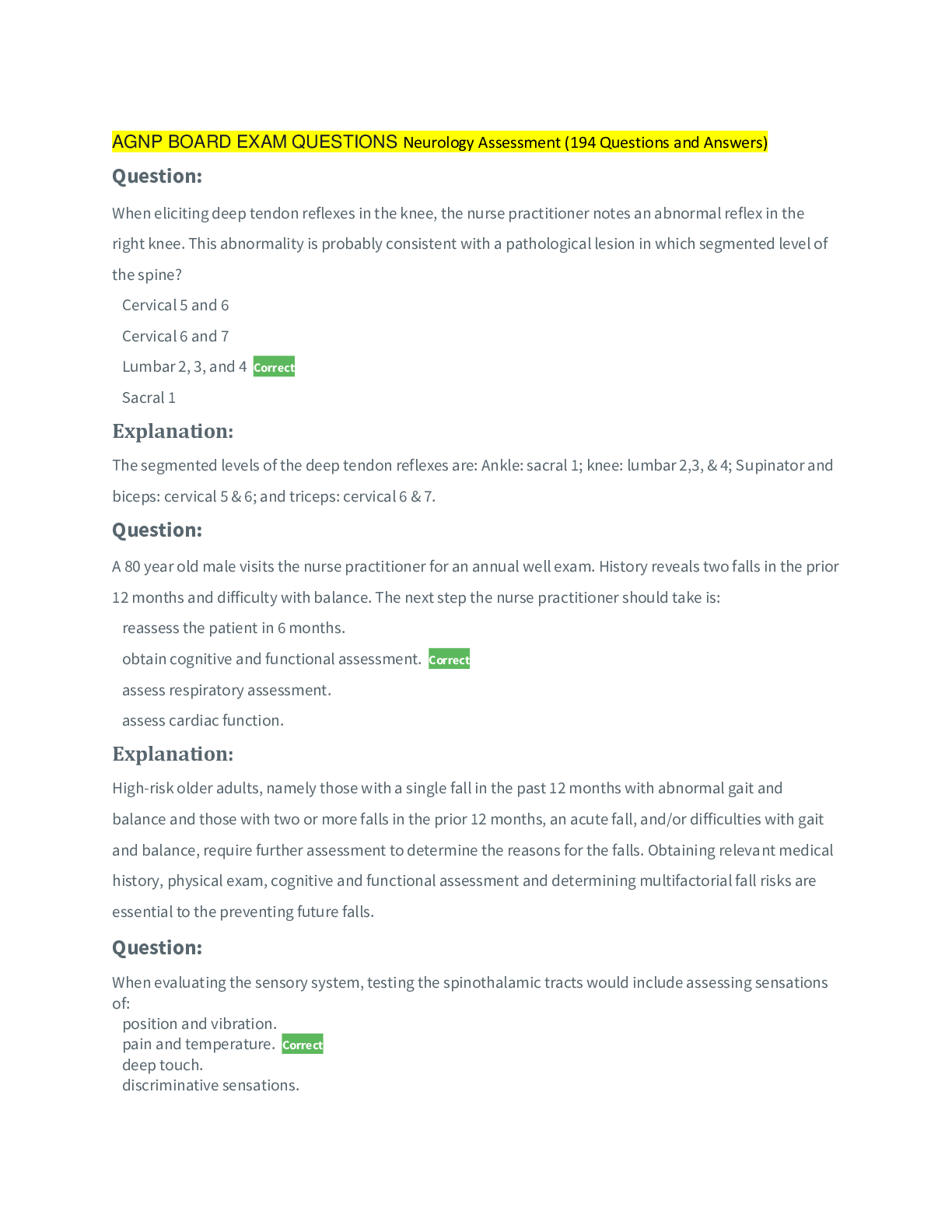AGNP BOARD EXAM QUESTIONS Neurology Assessment (194 Questions and Answers) Question: When eliciting deep tendon reflexes in the knee, the nurse practitioner notes an abnormal reflex in the right kne ... e. This abnormality is probably consistent with a pathological lesion in which segmented level of the spine? Cervical 5 and 6 Cervical 6 and 7 Lumbar 2, 3, and 4 Correct Sacral 1 Explanation: The segmented levels of the deep tendon reflexes are: Ankle: sacral 1; knee: lumbar 2,3, & 4; Supinator and biceps: cervical 5 & 6; and triceps: cervical 6 & 7. Question: A 80 year old male visits the nurse practitioner for an annual well exam. History reveals two falls in the prior 12 months and difficulty with balance. The next step the nurse practitioner should take is: reassess the patient in 6 months. obtain cognitive and functional assessment. Correct assess respiratory assessment. assess cardiac function. Explanation: High-risk older adults, namely those with a single fall in the past 12 months with abnormal gait and balance and those with two or more falls in the prior 12 months, an acute fall, and/or difficulties with gait and balance, require further assessment to determine the reasons for the falls. Obtaining relevant medical history, physical exam, cognitive and functional assessment and determining multifactorial fall risks are essential to the preventing future falls. Question: When evaluating the sensory system, testing the spinothalamic tracts would include assessing sensations of: position and vibration. pain and temperature. Correct deep touch. discriminative sensations. Explanation: When evaluating the sensory system, testing the spinothalamic tracts would include assessing sensations of pain and temperature. Assessing position and vibration evaluate the posterior columns. Light touch assesses both the spinothalamic and posterior column tracts. To assess discriminative sensation, both the spinothalamic and posterior columns tracts as well as the cortex would be assessed. Question: When testing for corneal reflex, an absent blink reflex is noted. This finding may be suggestive of a lesion in which cranial nerve? Cranial Nerve II (CN II) Cranial Nerve IV (CN IV) Cranial Nerve VI (CN V) Cranial Nerve VII (CN VII) Correct Explanation: When testing for corneal reflex, an absent blink reflex would be suggestive of a lesion in cranial nerves V or VII (CN V or CN VII)-Trigeminal or facial nerves. Question: An example of symmetric weakness is: the right shoulder. the right hand. both arms. Correct one the right side of the face. Explanation: There are 4 different patterns of weakness: Proximal, distal, symmetric, and asymmetric. An example of proximal weakness is weakness in the shoulder or hip girdle. Distal weakness occurs in the hands or feet. Symmetric weakness occurs in the same areas on both sides of the body. An asymmetric weakness occurs in a portion of the face or extremity - a form of focal weakness. Question: One maneuver used to assess coordination is to observe the patient: dorsiflexing the ankle. walking heel-to-toe in a straight line. Correct squeezing the examiner's fingers. counting to 10 backwards. Explanation: To assess coordination, observe the patient’s performance in rapid alternating movements, point-to-point movements, gait and other related body movements, standing in specified ways. Walking heel-to-toe would be an example of observing the patient's gait. Dorsiflexion would be assessing the patient's joint function. Squeezing the examiner's fingers would be one way to assess hand grasp. Counting has nothing to do with coordination. Question: Assessment of a 70-year-old's ability to maintain personal safety would be most adversely affected by declining function in the: cardiovascular system. respiratory system. sensory perception system. Correct gastrointestinal system. Explanation: The sensory system or sensory perception involves vision, touch, taste, smell, and hearing. With the aging process these perceptions are altered and these alterations put the elderly at risk for falls, burns, inability to smell smoke, and the inability to move fast enough to get out of harm's way. These impact personal safety. Changes in the cardiovascular, gastrointestinal, and respiratory systems do not usually lead to safety issues. Question: A patient complains of experiencing symptoms of nausea, diaphoresis, and pallor triggered by a fearful or unpleasant event. These symptoms are most likely associated with: subarachnoid hemorrhage. stroke. neurocardiogenic syncope. vasovagal syncope. Correct Explanation: In vasovagal syncope, a common cause of syncope, a prodrome of nausea, diaphoresis, and pallor are triggered by a fearful or unpleasant event, then vagally mediated hypotension, often with slow onset and offset. In syncope from arrhythmias, onset and offset are often sudden, reflecting loss and recovery of cerebral perfusion. Stroke or subarachnoid hemorrhage are unlikely to cause syncope unless there are focal findings and damage to both hemispheres. Question: An infant presents with an inappropriately increasing head circumference and hydrocephalus confirmed by CT scan. In addition to these findings, which one of the following would also be consistent with hydrocephalus? A soft, low-pitched cry Ability to be comforted easily Tense, bulging fontanels Correct Appropriately increasing weight Explanation: An infant with newly diagnosed hydrocephalus presents with a shrill and high-pitched cry. They are very irritable and do not comfort easily. Additionally, the infant's fontanels are tense and bulging due to the increased amount of cerebral spinal fluid (CSF) being produced or not being absorbed. These infants are very difficult feeders, so they often do not gain weight appropriately. ..............Continued [Show More]
Last updated: 3 years ago
Preview 1 out of 62 pages

Buy this document to get the full access instantly
Instant Download Access after purchase
Buy NowInstant download
We Accept:


AGNP BOARD EXAMS (23 Different Versions) ; Questions and Answers
By YourTutor 4 years ago
$95.5
23
Can't find what you want? Try our AI powered Search
Connected school, study & course
About the document
Uploaded On
Feb 01, 2021
Number of pages
62
Written in
All
This document has been written for:
Uploaded
Feb 01, 2021
Downloads
0
Views
117
Scholarfriends.com Online Platform by Browsegrades Inc. 651N South Broad St, Middletown DE. United States.
We're available through e-mail, Twitter, Facebook, and live chat.
FAQ
Questions? Leave a message!
Copyright © Scholarfriends · High quality services·